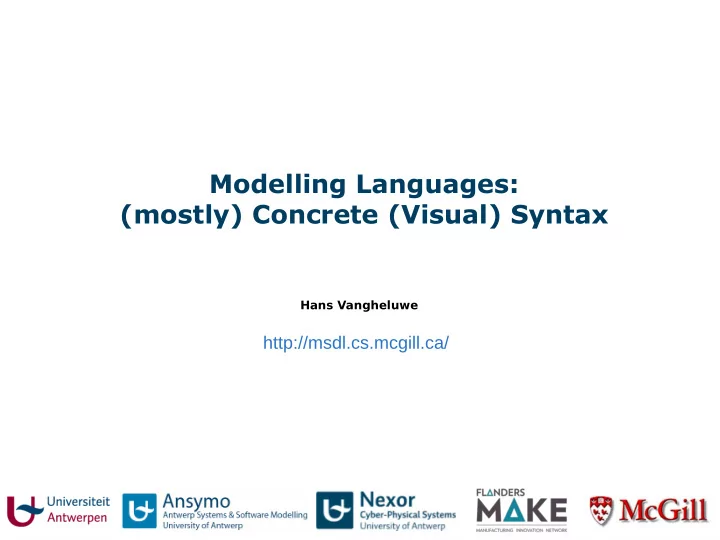

Modelling Languages: (mostly) Concrete (Visual) Syntax Hans Vangheluwe http://msdl.cs.mcgill.ca/
Modelling Languages/Formalisms Syntax and Semantics
Modelling Languages/Formalisms Syntax and Semantics Model of Graph 3
Textual Languages Textual Languages “this sentence is very short” ● Individual letters in an alphabet ● Combined into words ● Combined into sentences in a language ● Valid letters in words specified by reg egular exp xpressions ● Valid words in a language specified by a grammar ● letters/words are combined by “is to the right of”
Textual Languages syntax-directed editor (textual concrete syntax)
Visual Languages syntax-directed editor (visual concrete syntax)
Visual Languages
Visual Languages Plex
Visual Languages Grap aph
Visual Languages Co Connecti tion T Type pes
Visual Languages Iconic
Visual Languages Box
Visual Languages Visu sual L Langu guage age Cl Class sses
Visual Languages Hy Hybrid id L Langu guages
Visual Languages Syntax-dir irected V d Visu sual E al Editors: s: model l be behaviour
Visual Languages Syntax-dir irected V d Visu sual E al Editors: s: model l be behaviour
Visual Languages Generate te S Syntax tax-di directe ted V Vis isual l Edi dito tors
Visual Languages Syntax-dir irected V d Visu sual E al Editors: s: freehand d (early stages of multi-domain project)
Visual Languages Different M t Medi dia: : Gest stural I l Inte terac acti tion, S Sound, ... 20
``Physics'' of Notations Introducti tion ● Visual notations pre-date textual ones ● Visual notations are important for Modelling and Software Engineering ● Humans are excellent pattern recognizers ● Need cognitively efficient and effective notations. Cognitive effectiveness = speed, ease and accuracy with which a representation can be processed by the human mind a DSVL @ Lascaux
``Physics'' of Notations Introducti tion/R /Rati ationale le Visual notations are often introduced without underlying theory or rationale Many visual notations for same concepts. No rigorous way to co comp mpare re effectiveness and hence no clear design goal.
Maryam M. Maleki, Robert F. Woodbury, Rhys Goldstein, Simon Breslav, Azam Khan. Designing DEVS visual interfaces for end-user programmers. Simulation 91(8): 715-734 (2015)
``Physics'' of Notations Co Communicati tion T Theory
``Physics'' of Notations Encodi ding: 8 g: 8 v vis isual v variabl bles t s to (gr (graph phically) ) encode in information
``Physics'' of Notations Decodin ing automatic, fast, parallel slow, large effort, sequential Appropriate notations » offload some of the burden from cognitive to perceptual Note: “dual channel theory”: auditory/verbal channel and visual/pictorial channel are processed in parallel Richard E. Mayer, Roxana Moreno. Nine Ways to Reduce Cognitive Load in Multimedia Learning. Educational Psychologist, 38(1), 43–5. 2003.
``Physics'' of Notations Princip iple les f for D Desi sign gning g Effic fficient an t and E d Effecti tive V Visu sual N Nota tations
``Physics'' of Notations Clarity (semiotics = study of signs and sign processes) Semioti tic Cla 1- 1-to-1
``Physics'' of Notations Percept ptual D Disc scrimin inabi bili lity
``Physics'' of Notations Junaed Sattar, Gregory Dudek. Reducing Uncertainty in Human-Robot Interaction: A Cost Analysis Approach. ISER 2010: 81-95.
``Physics'' of Notations Percept ptual D Disc scrimin inabi bili lity should be easy to distinguish visual symbols ability to distinguish is determined by visual distance larger visual distance » faster, more accurate recognition ● number of visual variables on which they differ and the magnitude of the differences ● shape is the main visual variable 13
``Physics'' of Notations Percept ptual D Disc scrimin inabi bili lity Software Engineering notations mostly use rectangle variants Use re redundant visual encoding to in incr crease dis istance ce (e.g., textual + visual)
``Physics'' of Notations Semantic T Tran anspa parency The me meanin ing of a symbol can be in inferre rred from its appearance (intuitive) Symbols can be:
Semantic T Tran anspa parency: : semantically immediate symbols ``Physics'' of Notations
``Physics'' of Notations Semantic T Tran anspa parency
``Physics'' of Notations Semantic T Tran anspa parency The me meanin ing of a symbol can be in inferre rred from its appearance (intuitive) Symbols can be: • Semantically Immediate • Semantically Opaque Software Engineering notations are usually abstract (non-intuitive)
Seman anti tic T Tran anspar sparency: : semantically perverse symbols ``Physics'' of Notations
``Physics'' of Notations Semantic T Tran anspa parency The me meanin ing of a symbol can be in inferre rred from its appearance (intuitive) Symbols can be: • Semantically Immediate • Semantically Opaque • Semantically Perverse Domain-specific icons and visual arrangement should be intuitive
``Physics'' of Notations Compl Co plexity m management (# (# ele lements ts in in di diagr gram » c cognit itiv ive o overlo load) d)
``Physics'' of Notations Mo Modu dulariz izati tion/Hie /Hierarchy
``Physics'' of Notations Cognit Co itiv ive I Inte tegrati tion (d (different t notatio ions) s) ● Conceptual integration (cohere rent mental model) ● Enable navig igatio ion and transit itio ion between notations
``Physics'' of Notations Visu sual E Expr pressi siveness Number of visual variables used (UML, mostly shape, no colour) 8 degrees of visual freedom (0 = non-visual – 8 = visually saturated)
``Physics'' of Notations Visu sual E Expr pressi siveness Different visual variables have dif iffere rent ca capaci city to encode information
``Physics'' of Notations Dual l Encodin ing Combine Textual and Vis isual Supple lement rather than duplicate (e.g., multiplicity values) Rein inforce rce meaning
``Physics'' of Notations Grap aphic ic E Economy ● Not too many symbols. If many, provide le legend ● Limit on human discrimination capability (6 levels per variable) ● Upper limit on graphic complexity How?
``Physics'' of Notations Co Cognit itiv ive F Fit Adapt choice of visual notation to ● Task ● Audience (novices vs. experts) Adaptation may be dynamic (“learn” about Task/User proficiency) Representation medium matters
``Physics'' of Notations Interac actio ions a among g pr prin incipl ples
Recommend
More recommend